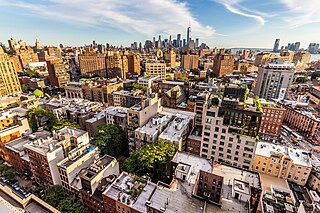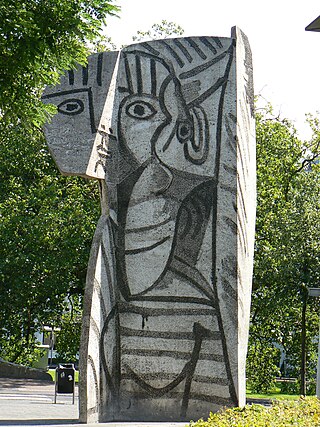
Greenwich Village, or simply the Village, is a neighborhood on the west side of Lower Manhattan in New York City, bounded by 14th Street to the north, Broadway to the east, Houston Street to the south, and the Hudson River to the west. Greenwich Village also contains several subsections, including the West Village west of Seventh Avenue and the Meatpacking District in the northwest corner of Greenwich Village.

The Solomon R. Guggenheim Museum, often referred to as The Guggenheim, is an art museum at 1071 Fifth Avenue between 88th and 89th Streets on the Upper East Side of Manhattan in New York City. It hosts a permanent collection of Impressionist, Post-Impressionist, early Modern, and contemporary art and also features special exhibitions throughout the year. It was established by the Solomon R. Guggenheim Foundation in 1939 as the Museum of Non-Objective Painting, under the guidance of its first director, Hilla von Rebay. The museum adopted its current name in 1952, three years after the death of its founder Solomon R. Guggenheim. It continues to be operated and owned by the Solomon R. Guggenheim Foundation.

28 Liberty Street, formerly known as One Chase Manhattan Plaza, is a 60-story International Style skyscraper between Nassau, Liberty, William, and Pine Streets in the Financial District of Manhattan in New York City. The building, designed by Gordon Bunshaft of Skidmore, Owings & Merrill (SOM), opened in 1961. It is 813 feet (248 m) tall.

The Bronx Community College of the City University of New York (BCC) is a public community college in the Bronx, New York City. It is part of the City University of New York system.

140 Broadway is a 51-story International Style office building on the east side of Broadway between Cedar and Liberty streets in the Financial District of Manhattan in New York City. The building was designed by Gordon Bunshaft, of the firm Skidmore, Owings & Merrill, and consists of a mostly smooth black facade on a trapezoidal plot. It is approximately 688 feet (210 m) tall, with approximately 1.17 million rentable square feet (109,000 m2). It is known for the distinctive sculpture at its entrance, Isamu Noguchi's Cube.

Sylvette is a large concrete sculpture created by Pablo Picasso and the Norwegian artist Carl Nesjar, which was erected in the city of Rotterdam in 1970. It is located on the corner of Westersingel next to the Museum Boijmans Van Beuningen. The sculpture portrays a young woman with a ponytail. The model for the sculpture was Sylvette David, whom Picasso met in 1953 when she was 19. The sculpture was produced following the creation of a series of artworks, known as the Sylvette series, that Picasso made of his muse in a variety of artistic styles.

The Chicago Picasso is an untitled monumental sculpture by Pablo Picasso in Daley Plaza in Chicago, Illinois. The 1967 installation of The Picasso, "precipitated an aesthetic shift in civic and urban planning, broadening the idea of public art beyond the commemorative."

The Low Memorial Library is a building at the center of Columbia University's Morningside Heights campus in Upper Manhattan in New York City. The building, located near 116th Street between Broadway and Amsterdam Avenue, was designed by Charles Follen McKim of the firm McKim, Mead & White. The building was constructed between 1895 and 1897 as the university's central library, although it has contained the university's central administrative offices since 1934. Columbia University president Seth Low funded the building with $1 million and named the edifice in memory of his father, Abiel Abbot Low. Low's facade and interior are New York City designated landmarks, and the building is also designated as a National Historic Landmark.
The urban campus of New York University (NYU) is located in Manhattan, and is around Washington Square Park in Greenwich Village, and also is in MetroTech Center in Downtown Brooklyn. NYU is one of the top three largest landowners in New York City.

Village Preservation is a nonprofit organization that advocates for the architectural preservation and cultural preservation in several neighborhoods of Lower Manhattan in New York City. Founded in 1980, it has advocated for New York City designated landmark status for a variety of sites like the Stonewall Inn and Webster Hall. The organization and its Executive Director, Andrew Berman, have been described as influential in New York real estate, while some of its activities to prevent development and to support restrictive zoning have attracted criticism.

University Village is a building complex owned by New York University in the Greenwich Village neighborhood of Manhattan in New York City, New York, U.S. University Village includes three residential towers built in the 1960s: 505 LaGuardia Place, a housing cooperative, and 100 Bleecker Street and 110 Bleecker Street, which house NYU faculty and graduate students. The buildings were designed by modern architects James Ingo Freed and I. M. Pei, and they surround a central plaza featuring the Bust of Sylvette sculpture by Carl Nesjar and Pablo Picasso. The complex also includes the John A. Paulson Center, a multipurpose building at 181 Mercer Street that was completed in 2021. The complex's original buildings and courtyard are a New York City designated landmark.

The Gould Memorial Library is a building on the campus of Bronx Community College (BCC), an institution of the City University of New York (CUNY), in University Heights, Bronx, New York City, United States. The building was designed by Stanford White of the firm McKim, Mead & White. Constructed between 1895 and 1900 as the central library of New York University (NYU)'s Bronx campus, it was part of the New York University Libraries system. The library is named after railroad magnate Jay Gould, whose daughter Helen Miller Shepard funded the project in his memory. Gould is no longer used as a library, instead serving primarily as an event space. Gould's facade and interior are New York City designated landmarks, and it is also listed on the National Register of Historic Places.

Kips Bay Towers is a 1,118-unit, two-building condominium complex in the Kips Bay neighborhood of Manhattan in New York City. The complex was designed by architects I.M. Pei and S. J. Kessler, with the involvement of James Ingo Freed, in the brutalist style and completed in 1965. Originally known as Kips Bay Plaza, the project was developed by Webb & Knapp as middle-income rental apartments, but was converted to condominiums in the mid-1980s.
Betograve is a type of concrete sculpting. A document published by the Nasher Sculpture Center says that betograve "...involves first pouring concrete into a form tightly packed with gravel, and, once set, precisely sand-blasting the surface of the concrete to expose the gravel beneath it". This "unique system of concrete placement" was first used by Carl Nesjar, a Norwegian painter, printmaker and sculptor. When Nesjar introduced the technique to Pablo Picasso, Picasso created a sculpture based on his folded sheet metal "Head of a Woman". The resulting piece "inaugurated a working relationship between Picasso and Nesjar that produced twenty-four works and lasted for the rest of Picasso's life".

Carl Nesjar was a Norwegian painter, sculptor and graphic artist. He is best known for his collaborations with Pablo Picasso; serving for nearly twenty years as Picasso's chosen fabricator — the artist who turned Picasso's drawings and scale models into large public sculptures. One such work was Picasso's Regjeringskvartalet murals which are located in Oslo, the city where Nesjar lived for most of his life. He is also known for his series of "Ice Fountains” which can be found in cities around the world.

The Grey Art Museum, known until 2023 as the Grey Art Gallery, is New York University's fine art museum. As a university art museum, the Grey Art Gallery functions to collect, preserve, study, document, interpret, and exhibit the evidence of human culture. While these goals are common to all museums, the Grey distinguishes itself by emphasizing art's historical, cultural, and social contexts, with experimentation and interpretation as integral parts of programmatic planning. Thus, in addition to being a place to view the objects of material culture, the Gallery serves as a museum-laboratory in which a broader view of an object's environment enriches our understanding of its contribution to civilization.

Diana Widmaier Picasso is a French art historian specialized in modern art, living in Paris.

Figure découpée or L'oiseau is an abstract sculpture by Pablo Picasso: there are a total of three Figure découpée sculptures. There is one located in Vondelpark NL, another on the campus of Massachusetts Institute of Technology in the United States and another is in Helsingborg Sweden. The sculpture is a depiction of a bird, but it is commonly referred to as flat bird, flat fish or fish statue.
















